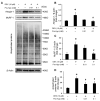Preventive Effects of Collagen-Derived Dipeptide Prolyl-Hydroxyproline against Dexamethasone-Induced Muscle Atrophy in Mouse C2C12 Skeletal Myotubes
- PMID: 38002299
- PMCID: PMC10669392
- DOI: 10.3390/biom13111617
Preventive Effects of Collagen-Derived Dipeptide Prolyl-Hydroxyproline against Dexamethasone-Induced Muscle Atrophy in Mouse C2C12 Skeletal Myotubes
Abstract
Glucocorticoids, commonly used to manage inflammatory diseases, can induce muscle atrophy by accelerating the breakdown of muscle proteins. This research delves into the influence of Prolyl-hydroxyproline (Pro-Hyp), a collagen-derived peptide, on muscle atrophy induced with dexamethasone (DEX), a synthetic glucocorticoid, in mouse C2C12 skeletal myotubes. Exposure to DEX (10 μM) for 6 days resulted in a decrease in myotube diameter, along with elevated mRNA and protein levels of two muscle-atrophy-related ubiquitin ligases, muscle atrophy F-box (MAFbx, also known as atrogin-1) and muscle ring finger 1 (MuRF-1). Remarkably, treatment with 0.1 mM of Pro-Hyp mitigated the reduction in myotube thickness caused by DEX, while promoting the phosphorylation of Akt, mammalian target of rapamycin (mTOR), and forkhead box O3a (Foxo3a). This led to the inhibition of the upregulation of the ubiquitin ligases atrogin-1 and MuRF-1. These findings indicate the potential significance of Pro-Hyp as a promising therapeutic target for countering DEX-induced muscle atrophy.
Keywords: Prolyl-hydroxyproline; collagen-derived peptide; mouse C2C12 skeletal myotubes; muscle atrophy; ubiquitin ligases.
Conflict of interest statement
The authors declare no conflict of interest.
Figures




References
Publication types
MeSH terms
Substances
Grants and funding
LinkOut - more resources
Full Text Sources
Research Materials
Miscellaneous

